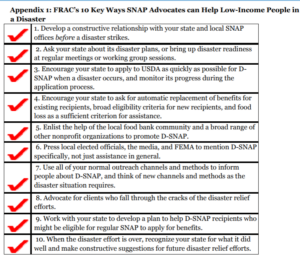As hurricane and wildfire seasons ramp up, here’s what you need to know about Disaster SNAP (D-SNAP)
Experts predict a 60 percent chance for an above-normal hurricane season this year. If so, then 2021 would be the sixth consecutive year with above-average hurricane activity. Hurricanes bring with them high winds, flooding, destruction, and death. Yet, they aren’t the only natural disaster we need to prepare for this summer and beyond.
Last year was California’s most devastating wildfire season in recorded history. An estimated 4.2 million acres burned. This year, California has already seen 1,000 more fires than it saw this time last year. Beyond California, climate change has brought increased drought conditions to many places across the U.S. As the average temperature of the earth rises, water more readily evaporates. This leads to disruptions in agriculture, the availability of drinking water, and an increase in the number of brush fires, which can become devastating wildfires.
D-SNAP for Hard–Hit Individuals
Whether your area’s disaster season is characterized by hurricanes, wildfires, tornadoes, floods, or other natural or human-caused disasters, there are federally funded programs in place to help hard-hit communities recover. On the nutrition side, Disaster SNAP (D-SNAP) “provides replacement benefits for regular SNAP participants who lose food in a disaster, and extends benefits to many households, which would not ordinarily be eligible but suddenly need food assistance.” For example, replacement benefits may be in order for a SNAP household that suddenly loses power or has to evacuate due to a disaster, causing the spoilage or destruction of their food.
D-SNAP is not automatically implemented in every disaster. Before D-SNAP can be offered, a state must seek approval from the U.S. Department of Agriculture (USDA). Households that qualify for D-SNAP can typically receive one month of benefits. After benefits have been approved, they are loaded directly onto an Electronic Benefit Transfer (EBT) card within 72 hours.
Households already receiving traditional SNAP benefits may qualify for disaster-related replacement and supplemental benefits. A supplemental benefit “brings [the SNAP household’s] benefits up to the maximum for their household size.” In many circumstances, rather than having SNAP participants in disaster areas apply individually for relief, states can get permission from USDA to provide the benefits through issuance of automatic mass replacements on SNAP households’ regular EBT cards.
For more information, find your state’s SNAP administrative office.
D-SNAP for SNAP Administrators
Traditionally, D-SNAP is implemented following “a presidential declaration of a major disaster,” though statutorily the Secretary of Agriculture can operate D-SNAP following a state’s request without a presidential declaration.
For states interested in implementing D-SNAP, the administrative tasks differ somewhat from those for traditional SNAP. D-SNAP often allows for more relaxed verification and reporting requirements. Moreover, during COVID-19, USDA has allowed much wider use of remote enrollment procedures, including telephonic interviews rather than the traditional in-person D-SNAP interviews. The disaster page on FRAC’s website has links to information on many waiver approvals granted in 2020, including for California, Louisiana, and Tennessee.
D-SNAP for Advocates
The time to prepare for disasters is now. Disasters often entail loss of electricity and internet access, as well as the possible destruction of the documents necessary to file for D-SNAP. Advocates should conduct outreach to SNAP-eligible people, especially in areas where disasters are most likely to occur. This would help get more people connected to the benefits that could provide them with more resources going into a disaster event, and make it easier for states to get relief to those people after the disaster has struck. Advocates should target outreach to particularly vulnerable demographic groups: older Americans, persons with disabilities, people living in poverty, low-income immigrant families, families whose first language is not English, and homeless individuals.
For D-SNAP, as with regular SNAP, advocates should partner with local organizations who already have a rapport with or connection to underserved individuals. Outreach materials should reflect relevant languages and offer clear information about how households apply, including what documents they will need to provide.
In areas like Florida and Louisiana, which have a “pre-registration” process for D-SNAP, advocates should help households pre-register for D-SNAP, and then prepare to assist them when the actual D-SNAP application process begins.
After D-SNAP has concluded, many former D-SNAP participants may be low-income households that would qualify for regular SNAP. Advocates should provide information on how such former D-SNAP households can transition to regular SNAP. Leveraging regular SNAP benefits also will assist households to put much-needed food on their table, and pump much-needed revenue into the economy. Low-income families often are hit the hardest by disaster and frequently experience slower rates of recovery. Advocates should work with states and other stakeholders to increase equity and parity in a community’s pre-disaster planning and in post-disaster recovery and rebuilding phases.


